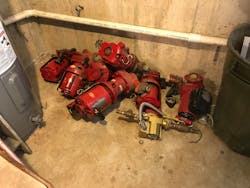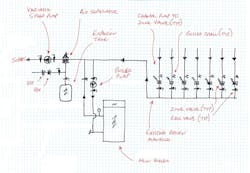Variable speed pumps have been around for years. As I mentioned in last month’s article, I used the technology at my own home at the turn of the century. A control varied the speed of a pump in an injection loop to control water temperature in a heating loop. The design was inspired by an article in a magazine like this.
Come to think about it, there were two variable speed pumps. One heated the house with a reset water temp and one heated the domestic hot water with a fixed water temp. This was back in the days of keeping a cast iron boiler at 180 degrees 24/7. Great for comfort, but not so great for efficiency. When I switched to a mod-con boiler in 2006 or so, the variable speed pumps left the house.
About that time, pump manufacturers were starting to develop variable speed pumps that worked independent of separate controls in the sizes that I work with. This got me to thinking (which can be a dangerous thing). I cooked up an idea to rock the hydronics world, but I was using the wrong recipe.
Let’s get a disclaimer out of the way. I know very little on my own. The credit for what I do know goes to those who years ago figured out how this stuff works. Hydronics is a small portion of the HVAC pie, and I have worked in the same slice for over 35 years. So, when I get technical about something, the wisdom comes from plenty of field experience and working with the industry experts.
So let’s get technical for a minute on how a boilers reacts to variable water flow. With an on/off boiler and a constant input, as the flow rate decreases through the boiler, the btu’s stay the same and the temperature difference (Delta T) increases. Same input – Lower flow – High Delta T. Without any flow the boiler goes off on the high temperature limit and /or starts dancing a jig.
Mod-cons get their best efficiencies from condensing the flue gases, based on the return water temp. The lower the return water temp, the higher the efficiency. You all know that, but I want that fact to sink in because I will talk about that for years to come.
Anyway, we learn from the good stuff that happens, and how to repeat it. We can also learn from our mistakes. That industry rocking idea was to use a variable speed pump as the boiler pump for a mod-con boiler. The pump was new on the market and varied its speed based on Delta T. I was observing that mod-cons were rarely operating at 100% modulation for space heating, therefore in my misguided theory, since the pump didn’t need to be at full speed, if we slowed down the pump, it could help peak the efficiency from less electrical energy used and from lower return water temps to condense flue gasses.
Somehow I sold this idea on a couple of jobs. However, as Mick sings, you can’t always get what you want. We didn’t blow a fifty amp fuse, just caused numerous high temp lockouts. The mistake of applying a variable speed pump to a modulating burner seems obvious in retrospect, but most things do. The speed of the pump and the modulation of the burner have to be varied by the same control. Without that coordination, if the pump is slowing down as the burner is modulating up, the boiler control senses that sudden rise in temperature and locks out on high temp, like there’s no flow.
Some boilers now come with the built-in smarts to allow the pump speed to ride with the burner modulation rate. One control telling two varying devices to play nice together. That’s all I wanted, but I didn’t know it at the time.
Another application for a variable speed pump is multiple two-way zone valve systems, or a system with changing flow rates. Photo A shows a gaggle of zone valves to the right of a variable speed pump. This generation of variable speed pumps can internally sense how many valves are open or closed and adjust its speed accordingly.
At this shack, which looks like stately Wayne Manor as you drive up, each zone valve controls flow to back-up hot water coils in geothermal air handlers. Geothermal was all the rage in this high-end neighborhood years ago and during the previous gutting of the house, a steam system was removed—after I had spent my career keeping it working. Down in the Batcave, the old boiler room became a home theater, complete with a sloped floor since it was a half story below the basement level to allow gravity return of the condensate to the old steam boiler. I can’t make this up.
This fall, a contractor asked me to meet him at the job to discuss adding a pool heater to the recently installed high efficiency hot water system. I recognized the place when I got there, but was confused by all the construction activity. It turns out a new owner is remodeling the place, once again. You have to love rich people, all their remodeling keeps the economy going.
We determined that adding another zone valve to the existing gaggle would work. My concern was the pressure drop through the new pool heat exchanger, since sometimes that can surprise you. Fortunately, the existing variable speed pump develops enough head pressure to overcome the researched loss through the heater.
This variable speed pump was fully adjustable, with about six modes of operation. We started the pump in the automatic adaptive mode. It somehow “learns” how to speed up and slow down, but it can take a few days. After a week of weak performance, the pump was switched to the constant pressure mode. Where I don’t know the ins and outs of the auto adapt mode and its algorithms, I can say that multiple pump manufactures recommend the constant pressure mode for multiple zone valve applications. The mode switch did the trick.
So I took a broad view of variable speed pumps to get you excited about the wide application for this latest and greatest technology. Talk to your pump rep about what wiz bang variable speed pump they now offer the next time he or she stops in with the donuts. Next month we go back to the basics, static fill pressure. Gee that sounds exciting.
Patrick Linhardt is a thirty-five year veteran of the wholesale side of the hydronic industry who has been designing and troubleshooting steam and hot water heating systems, pumps and controls on an almost daily basis. An educator and author, he is currently Hydronic Manager at the Corken Steel Products Co.
About the Author
Patrick Linhardt
Patrick Linhardt is a forty-one-year veteran of the wholesale side of the hydronic industry who has been designing and troubleshooting steam and hot water heating systems, pumps and controls on an almost daily basis. An educator and author, he is currently Hydronic Manager at the Corken Steel Products Co.


